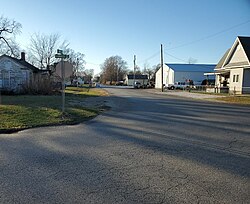Summum, Illinois | |
|---|---|
 View down Sand Branch Road in Summum. | |
| Coordinates: 40°16′04″N90°16′42″W / 40.26778°N 90.27833°W | |
| Country | United States |
| State | Illinois |
| County | Fulton |
| Elevation | 623 ft (190 m) |
| Time zone | UTC-6 (Central (CST)) |
| • Summer (DST) | UTC-5 (CDT) |
| Area code | 309 |
| GNIS feature ID | 419359 [1] |
Summum is an unincorporated community in Fulton County, Illinois, United States. Summum is located adjacent to U.S. Route 24 northeast of Astoria, in Woodland Township.
Contents
Summum gives its name to the Summum cyclothem and the associated "Summum coal" formation, which extends over much of western Illinois but is typically only a few inches thick. [2] [3]
One place the Summum coal reached a minable thickness was just north of Summum itself, where a strip mine was operated in the mid-20th century, from 1948 to 1955 by Key Coal Company and for some time thereafter by Peabody Coal Company. [4] The strip mine was later converted into a small lake. [5]
Notable people from Summum include country musician and comedian Smiley Burnette, who was born there in 1911. [6]


